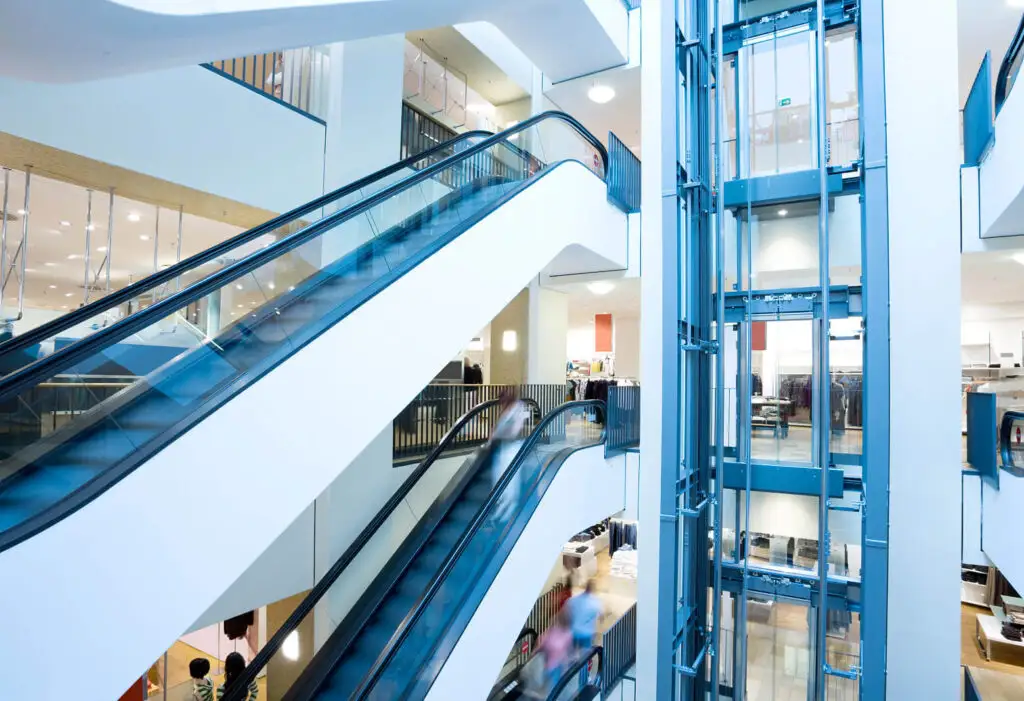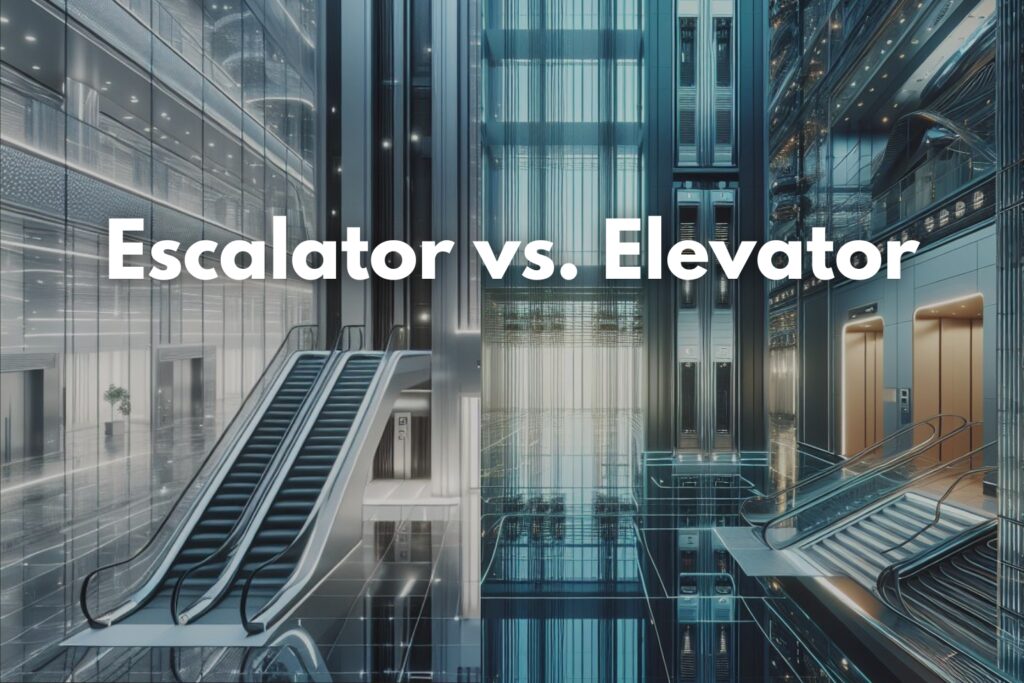Choosing between escalators and elevators is an important decision in building design. Both help move people between floors, but they’re quite different. This article explains these differences in a simple way. I’ll cover how much space they need, where they work best, their energy use, and their costs. This information is key to making good choices for any building.
Design and Space Requirements
Escalators: Horizontal Space and Design Limits
Escalators are unique in their space needs, requiring a larger horizontal area compared to their vertical reach. This means they take up more floor space to move people between levels. Typically, escalator designs are straightforward, often running in straight lines or gentle curves.
This simplicity, however, limits creative design options. Escalators are most efficient in places where there’s enough ground space to accommodate their length, making them a common sight in areas like shopping centers and transit stations.
Elevators: Vertical Orientation and Customization
In contrast, elevators are designed to move directly up and down, needing vertical space for shafts. They often require additional space for machine rooms, though newer models can operate without these, saving space.
Elevators provide more design flexibility, easily integrating into various architectural styles and building types. They can be customized in size, interior design, and even the technology they use, making them suitable for a wide range of buildings.
Space Efficiency Comparison
Elevators have an advantage when it comes to efficiently using space, particularly in tall buildings. Their vertical design means they occupy less floor space, an important consideration in high-rises.
Escalators, while less space-efficient vertically, are ideal for buildings with large ground floors and a need for moving large crowds over shorter vertical distances, like in malls or airports. The choice between an escalator and an elevator largely depends on the building’s design, height, and the volume of foot traffic it handles.

Usage and Applications
Escalators: Ideal for High Traffic Public Spaces
Escalators are a common sight in places like shopping centers, airports, and metro stations. These locations benefit from the ability of escalators to move a large number of people quickly and continuously.
Unlike elevators, escalators don’t have waiting times. People can step on and off at their own pace, which keeps the crowd moving smoothly. This is particularly useful during peak hours when the flow of foot traffic is highest.
Elevators: Catering to Diverse Building Needs
In comparison with escalators, the elevators are a better fit for residential complexes, healthcare facilities, and tall office buildings. They are essential for transporting people, especially those with mobility challenges, across different floor levels.
Elevators can travel higher and offer a private, controlled space, making them suitable for environments where individual comfort and accessibility are priorities. They’re also vital in tall structures where escalators would be impractical due to their height limitations.
Making the Right Choice
When deciding between escalators and elevators, it’s important to consider the building’s height and primary purpose. A shopping mall with multiple levels might benefit more from an escalator for its open floors, while a high-rise apartment would require an elevator for its efficiency in vertical travel. Similarly, the expected volume of people using the facility plays a crucial role. High foot traffic areas are more escalator-friendly, while elevators are preferable in less crowded, more private settings.
Advantages and Disadvantages
Advantages of Escalators
- Continuous Movement: Escalators are constantly in motion, transporting people without any waiting period. This feature is particularly beneficial in areas with heavy foot traffic.
- Aesthetic Appeal: In commercial settings like malls and airports, escalators add a modern and dynamic element to the architecture, enhancing the overall visual appeal of the space.
- Efficiency in High-Traffic Areas: Escalators are excellent for moving large numbers of people efficiently, especially over short distances.
Disadvantages of Escalators
- Height Limitations: Escalators are not suitable for very high buildings as they can only cover a limited vertical distance effectively.
- Accessibility Issues: For individuals with mobility challenges, such as wheelchair users, escalators can be difficult or impossible to use, posing a significant accessibility concern.
Advantages of Elevators
- Access to Higher Floors: Elevators are capable of traveling to much higher floors than escalators, making them indispensable in tall buildings like skyscrapers and high-rise apartments.
- Accessibility: Elevators are equipped to accommodate everyone, including those with disabilities, providing an inclusive solution for vertical transportation.
Disadvantages of Elevators
- Waiting Time: One of the main disadvantages of elevators is the waiting time, especially during peak hours in office buildings or residential complexes.
- Limited Capacity: Elevators can only carry a certain number of people at a time, which might not be sufficient during periods of high demand.
Considerations in High-Traffic Scenarios
In busy environments, the choice between escalators and elevators depends on the specific needs of the building. While escalators can move more people quickly over shorter distances, elevators are essential for taller structures despite potential wait times and capacity limitations. The decision should be based on the building’s height, the expected volume of users, and accessibility requirements.

Energy Efficiency and Environmental Impact
Energy Consumption Patterns
- Escalators: Often running continuously, escalators can be energy-intensive. However, modern escalators are equipped with energy-saving features. One such feature is the auto-start mechanism, which activates the escalator only when needed, reducing electricity usage during off-peak hours.
- Elevators: Recent advancements have significantly improved their energy efficiency. Notably, the introduction of regenerative drives in elevators marks a leap forward. These drives capture the energy generated when the elevator descends and feed it back into the building’s power grid, effectively reducing overall energy consumption.
Environmental Considerations
- Materials and Construction: The environmental impact of these transportation systems is not limited to energy consumption. The materials used in their construction, such as metals, plastics, and electronic components, also play a role. Selecting sustainable materials and construction methods can minimize this impact.
- Recycling Potential: End-of-life recycling possibilities are an important aspect of their environmental footprint. Both escalators and elevators contain recyclable materials that, if properly reclaimed, can reduce waste and support a circular economy.
Adopting Sustainable Improvements
The trend in both escalator and elevator design is moving towards sustainability. This involves not only improving energy efficiency but also considering the full lifecycle impact of these systems. Innovations are continuously being explored to create more eco-friendly escalators and elevators, from the materials used in their construction to the energy they consume during operation.
Cost of Installation and Maintenance
Initial Investment: Installation Costs
- Escalators are cheaper to install than elevators. They are simpler and better for buildings with less vertical distance. Additionally, their standard design allows for easier integration into various spaces. This cost advantage makes them a popular choice in settings like shopping malls and transit stations.
- Elevators cost more, especially in tall buildings. They need more complex parts like shafts and machine rooms. The investment in elevators, however, is justified by their ability to efficiently move people across numerous floors, crucial in high-rise buildings and hospitals.
Ongoing Care: Maintenance Requirements
- Escalators need more frequent upkeep due to dust and debris. This can increase their overall cost over time. Regular cleaning and part replacements are essential to keep them running smoothly. This consistent maintenance ensures safety and longevity but adds to the total expense.
- Elevators have longer periods between maintenance but can be expensive when needed due to their complexity. Their enclosed nature protects them from daily wear but requires skilled technicians for repairs. This infrequent but high-cost maintenance is a factor to consider for long-term budgeting.
Long-Term Perspective: Cost-Benefit Analysis
Performing a cost-benefit analysis is essential. For escalators, factor in the regular maintenance alongside the lower installation cost. For elevators, weigh the higher upfront cost against the potentially lower long-term maintenance expenses. This analysis helps in making an informed decision based on the expected lifespan and usage patterns of the system.
Understanding these financial aspects ensures that the choice between an escalator and an elevator aligns with both the immediate budget and long-term financial planning of a building project.
Future Trends in Vertical Transportation
Smart Technology
Elevators are getting smarter with AI. This means they can work out the busiest times and move more efficiently, making your ride quicker and smoother. AI integration also allows for personalized experiences, like remembering preferred floors and enhancing user convenience.
Elevator Modernization Service
Elevator Modernization Service is about making old elevators better and more modern. It means adding new technology to improve their work, making them safer and more efficient. This is a smart way to update elevators without replacing them entirely, which saves money. These upgrades can make elevators use less energy, be easier to control, and look nicer, fitting in with newer building styles.
Energy-Saving Designs
Both escalators and elevators are cutting down on energy use. New escalators use less power when not in use, and elevators can now generate power while they work. This is good for both your wallet and the planet. These advancements contribute significantly to reducing the overall energy footprint of buildings.
Predictive Maintenance
Thanks to new tech, escalators, and elevators can tell when they need fixing before they break down. This means fewer surprises and more reliable rides. It also leads to cost savings for building owners, as it helps avoid major repairs and downtime.
Eco-Friendly Focus
We’re now using greener materials and designs for escalators and elevators. This helps protect the environment and aligns with global eco-friendly efforts. Additionally, these sustainable practices are appealing to environmentally conscious consumers and businesses.
Better for Everyone
These systems are being made easier to use and more welcoming for all people, including those with disabilities. This means a more comfortable and inclusive experience for everyone. The aim is to create a barrier-free environment, enhancing accessibility for all building users.
In short, the future is all about elevators and escalators that are smarter, greener, more reliable, and user-friendly. These trends improve efficiency and cater to a wider range of users, making vertical transportation a more integrated part of our daily lives.
Conclusion
Deciding whether to use escalators or elevators in a building comes down to what you need and can afford. Escalators are great for moving a lot of people quickly in places like malls or airports, but they can’t go very high. Elevators, on the other hand, can reach higher floors and are better for a wide variety of buildings, including those that need to be accessible to everyone.
Both options are getting more advanced and eco-friendly. When choosing, think about what your building is for, who will use it, and the latest trends in lifts and escalators. Make a choice that fits your building’s needs now and in the future.






